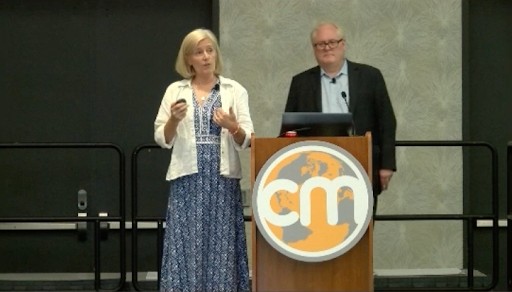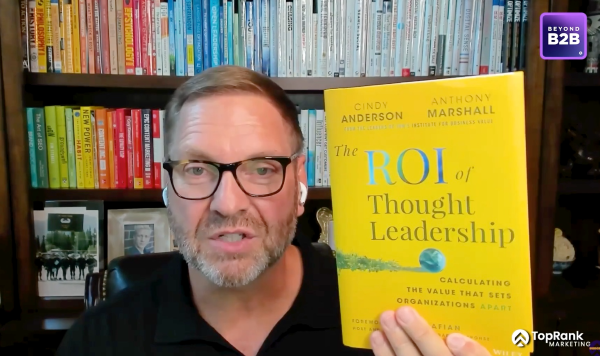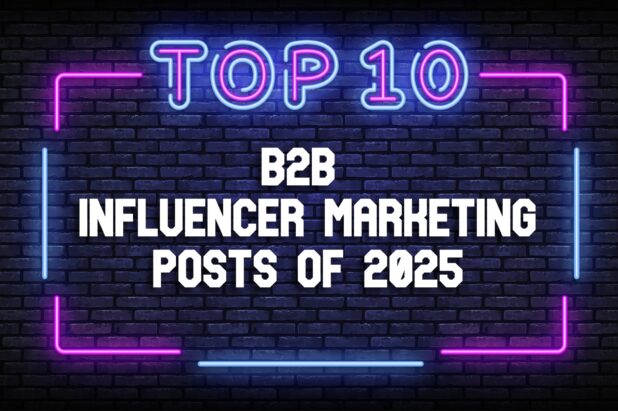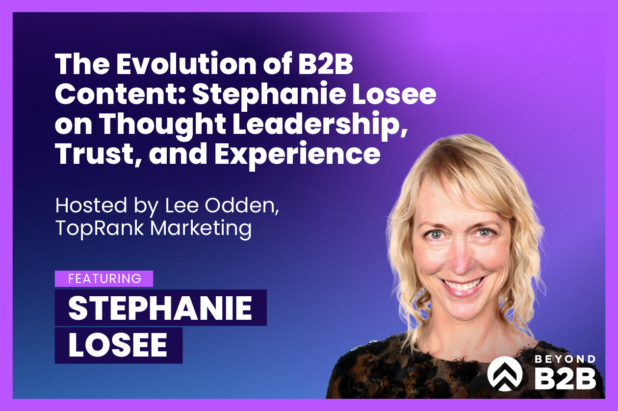If you’ve taken marketing classes at University or worked in the field for a while, you’re probably familiar with the “7 Ps” of marketing (product, price, place, promotion, people, process, and physical evidence).
According to new research shared at this year’s Content Marketing World by Cindy Anderson and Anthony Marshall of the IBM Institute for Business Value, it’s time to make room for an eighth: Platform. As in Thought Leadership as a platform.

In their session, “Thought Leadership as the 8th P of Marketing,” Cindy and Anthony presented data from one of the most extensive global studies ever conducted on the business value of thought leadership. Their findings help quantify what many thought leadership and marketing practitioners have known, but struggled to effectively prove: that thought leadership is more than a brand building effort, it drives measurable revenue outcomes for business.
While most B2B marketers are sorting out where AI best fits in their mix, the hunger for trusted, data informed human perspectives that decision makers can rely on to solve their business problems is growing. That’s why I think this research, book and presentation from Cindy and Anthony on thought leadership as a platform is more timely than ever.
Thought Leadership defined: Distinctive, evidence-based, and action-oriented
In their new book, The ROI of Thought Leadership: Calculating the Value That Sets Organizations Apart (Wiley, 2025), Cindy and Anthony define thought leadership as:
“Distinctive, evidence-based intelligence that gives leaders the insights they need to make better business decisions and the inspiration to act.”
That definition underscores two important distinctions for most B2B marketers: First, that true thought leadership is grounded in data and insight, not just opinion. Second, that it serves a business purpose, inspiring action among decision-makers.
Another important distinction is that in this framework, thought leadership is not the same thing as content marketing. Rather, it can be the platform on which all other marketing activity is built. In practice, that means campaigns, storytelling, and brand experiences are most effective when they are informed by distinctive, credible insights that position the business as a trusted authority.
This distinction is very much in line with what TopRank Marketing’s Best Answer Marketing approach calls the Trust Engine, the strategic architecture of credibility built through authoritative voices, original research, and data-informed storytelling – validated by credible third party publications.
Proving the ROI: 156% returns that outperform traditional marketing
Despite the general importance of thought leadership, the discipline has historically been difficult to quantify. IBM’s research, conducted in partnership with Oxford Economics and based on surveys of 4,000 global C-suite executives, set out to change that. Their analysis found that, on average, thought leadership delivers an ROI of 156%. By comparison, traditional marketing campaigns yield an average ROI of just 9%.
I think you can agree, the difference is striking. It positions thought leadership not only as a brand-building exercise, but as a financial growth engine that can multiply marketing impact across the funnel.
As Cindy and Anthony put it during their presentation, the data finally gives CMOs and CFOs a “budget justification” for treating thought leadership as a central investment, not just a discretionary one.
Why executive solution buyers turn to thought leadership content
The research also revealed why executives are engaging with thought leadership at such high levels and why it has such strong commercial influence. For example:
- Globally, thought leadership drives $265 billion in spending every year ($100 billion in the US alone!)
- 88% say they use TL to overcome inadequate data and analysis in their own organization
- 59% say TL delivers higher levels of profitability and 46% say it drives higher revenue growth
- 96% say they make better business decisions and 93% say they are stronger competitively
- 30% of all IT purchases are also influenced by thought leadership = $435 million
- Thought leadership ROI of 156% on average, 16× better than traditional marketing (9%)
These insights underscore that thought leadership actively shapes strategic decision-making and purchasing behavior at the highest levels of business.
As Cindy Anderson shared in our recent discussion on the Beyond B2B Marketing podcast,
“Executives are looking for content that’s generous with insight and grounded in evidence – something that helps them do their jobs better.”
That intent to inform and enable is what separates thought leadership from content that is simply promotional.
Inside the thought leadership ROI model: A practical framework for B2B marketers
To move beyond abstract valuation, Cindy and Anthony’s research efforts outlined a model specifically for calculating the return on thought leadership. The formula considers both direct and influenced client spend – purchases directly driven by thought leadership and those where it played an attributal role.
The key components of their thought leadership ROI calculation include:
- Direct Spend – Immediate purchases attributed to thought leadership.
- Influenced Spend – Purchases indirectly influenced by it.
- Mindshare – The brand’s share of attention among trusted sources.
- Client Base and Reach – The proportion of clients consuming thought leadership.
- Profit Margin – Converting total revenue impact into profit.
Using industry averages, their thought leadership ROI model estimated:
- $85 million in direct spend
- $22 million in realized influenced spend
- A total client spend of $107 million
Adjusted for mindshare (10%), client base (200), and reach (30%), this amounts to $64 million in profit, achieved from an average $25 million investment. The outcome: 156% ROI.
From content to platform: Making thought leadership the 8th P
The core argument Cindy and Anthony made is that thought leadership is not simply a brand building campaign, but a platform upon which marketing activities can be spawned. A thought leadership platform provides the foundation upon which brand, demand, and lead-generation efforts can be built as a full funnel effort.
That concept aligns very strongly with what TopRank defines as Integrated Strategy within Best Answer Marketing, the orchestration of insights, narratives, and distribution channels around high-value answer topics that demonstrate credibility and drive measurable outcomes.
If I can indulge consideration of both approaches including the 6 pillars of BAM, thought leadership fuels:
- Original research (Data-Informed)
- Trusted relationships (Trust Engine)
- Compelling, multi-format content experiences (Experiential Content)
- Cross-channel visibility (Multi-Channel Discovery)
- ROI optimization (Full-Funnel Analytics)
This approach reinforces the idea that the most effective marketing starts with insight that audiences can believe and act on, not a simple campaign.
What It Means for B2B Marketers: For marketers that want to elevate their programs, the findings from IBM’s study suggest three takeaways:
1. Treat thought leadership as infrastructure, not output.
Build your content ecosystem around credible, research-based insights that can serve as the foundation for brand and demand initiatives.
2. Focus on trust and utility.
The most valuable thought leadership helps decision-makers think AND have the confidence to take action.
3. Quantify what you can.
Use ROI modeling to justify investment in thought leadership to demonstrate measurable business impact across the funnel from brand to demand to revenue outcomes.
As B2B marketing continues to evolve in the age of AI and information overload, data-backed thought leadership as a platform offers something algorithms and AI chat platforms are increasingly rewarding with visibility and that humans are hungry for: credibility, distinctiveness and confidence.
Research-Driven Thought Leadership as a Platform for B2B Marketing
I think Cindy and Anthony’s “8th P” of marketing helps reframe thought leadership as more than a tactic. It can be a platform that unites brand purpose, audience intelligence, and creating business value.
For B2B marketers, that could be both validation and a call to action. With attention growing harder to earn and trust an increasingly valuable currency, building a thought leadership platform is becoming essential for B2B marketing that builds, grows and performs.
Check out Cindy and Anthony’s book, The ROI of Thought Leadership here.
And watch, listen or read a summary of my conversation with Cindy on the Beyond B2B Marketing podcast.
More about the researchers/presenters:
Cindy Anderson is Senior Vice President of IBM’s Institute for Business Value where she drives research that shapes C-suite decisions worldwide. A recognized thought leadership strategist, she translates complex business and technology trends into actionable insights for executives. Her work has been featured in Harvard Business Review, Forbes, and The Wall Street Journal, helping organizations navigate digital transformation with data-driven confidence.
Anthony Marshall brings over two decades of strategic intelligence expertise to his role as Partner and Research Director at IBM’s Institute for Business Value. He has pioneered groundbreaking studies on AI adoption, sustainability transformation, and competitive strategy that influence billions in executive spending decisions annually. A sought-after advisor to Fortune 500 leadership teams, Anthony combines analytical rigor with storytelling to make emerging business trends accessible and actionable.
To learn more about Full Funnel Thought Leadership to drive brand, demand and revenue outcomes, be sure to check out my presentation at MarketingProfs B2B Forum, November 18th in Boston.




